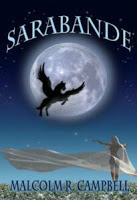Fantasy often begins with an old myth or legend

"We call it Lightning Falls," said Marten. "Deucalion named it so. A holy man appeared to him in a dream and said, 'Stand inside the storm and you will find nothing but the freedom of your dreams.' The sky was black at noon, so the story goes, when lightning struck the rock, creating a tunnel. A thousand people walked through before time closed the portal and guarded it with a pillar of fire." -- from "The Sun Singer"
Alice steps into a fantasy world via a rabbit hole. Lucy finds Narnia via a wardrobe in a professor's house. Harry Potter walks through a hidden passageway at a London train station. In my 2004 novel The Sun Singer, Robert Adams finds Pyrrha via a remote mountain cabin.
Hidden worlds in fantasy novels are frequently reached via portals or tunnels, and they open up before the reader and the protagonist as realities complete with customs, characters, background myths and legends. My alternative world is called Pyrrha, named after the wife of Deucalion from the Greek myth of the flood. (The graphic here shows Deucalion and his Pyrrha in the version of the story told my Ovid.)
North American Connection
In The Sun Singer, the residents of Pyrrha believe that Deucalion and Pyrrha came to North America as they fulfilled their orders from Zeus to repopulate the world. To avoid conflict, they left the reality that would ultimately become Glacier National Park and followed a tunnel into a look-alike world they named Pyrrha.
Greece, Zeus, Deucalion and Pyrrha have nothing to do with the plot of The Sun Singer. I included them in the book to give the world of Pyrrha a solid foundation. Likewise, readers of Alice's Adventures in Wonderland, The Chronicles of Narnia, and Harry Potter and the Sorcerer's Stone also find secret worlds that not only exist in the here and now, but also have a history to them. Tolkien, of course, went further than anyone in creating a living and breathing world in Lord of the Rings.
Sarabande Leaves Pyrrha and Returns

Fantasy, like its cousin magical realism, needs an anchor to keep it from becoming wholly speculative and ephemeral. I grew up with the Athurian legends, Middle Earth, and Narnia, and was always impressed by the fact that the masters of fantasy gave readers a lot more than a thinly constructed arena for the here-and-now adventures of their stories. They created worlds with as much depth as our own.
Like The Sun Singer, my upcoming fantasy adventure novel Sarabande gets its depth from the myths and legends behind the world or Pyrrha as well as the very real mountain world of Glacier National Park. My intention here is to give the reader the impression that my protagonist Sarabande's journey begins and ends at a place so real, her story quite possibly is true.
In The Sun Singer, young Robert Adams finds adventure by leaving his home in Illinois, traveling to Glacier Park and discovering Pyrrha. In Sarabande, the young Sarabande finds adventure by leaving and then returning to Pyrrha. That is, her trials and tribulations occur on both sides of the magic doorway between worlds.
Readers already believe in the stuff of which their own world is made. If I can lure them into believing in the stuff of my fantasy world, then I have a strong foundation for telling them a good story. Background myths and legends are an old writing technique that can be a writer's best friends.
--Malcolm
Published on August 13, 2011 07:38
No comments have been added yet.



